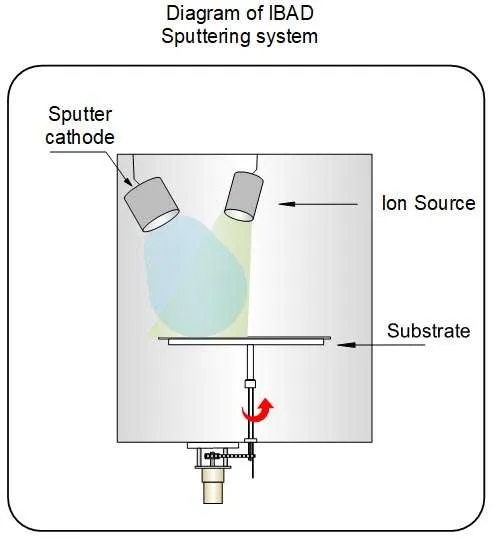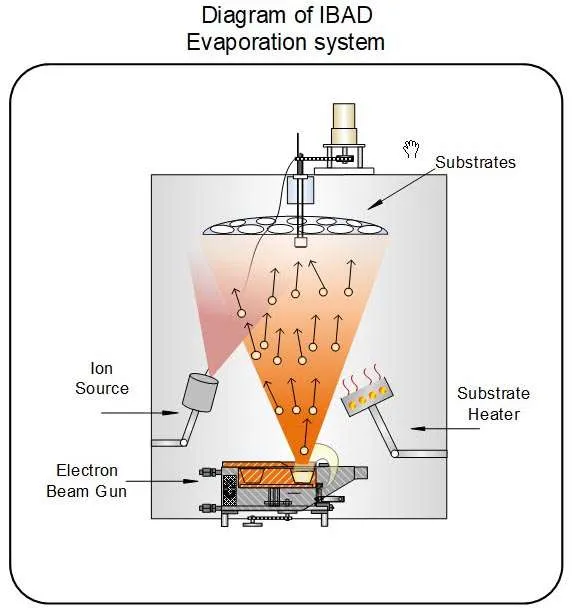

During an ion-assisted deposition process, ion beams bombard the substrate's surface, etching and cleaning it before the actual deposition. Additionally, ion assistance enhances coating durability by converting the tensile stress (arising from differences in the materials' coefficients of thermal expansion) into compressive stress, which increases the density of the thin film layers.
Ion Beam Assisted Deposition (IBAD) Overview
Ion Beam Assisted Deposition (IBAD) is an advanced thin-film deposition technique that can be integrated with sputtering or thermal evaporation to create high-quality films with precise control. IBAD is defined by the simultaneous ion beam bombardment of a substrate as a physical vapor deposition (PVD) coating is applied in a high-vacuum environment. This setup allows independent control over ion bombardment and deposition parameters, maximizing process precision.
IBAD, known by various names like Ion Assisted Deposition (IAD), Ion Assisted Coating (IAC), Ion Beam Enhanced Deposition (IBED), Ion Beam Sputtering (IBS), and Ion Vapor Deposition (IVD), is most commonly referred to as IBAD in the industry.
How IBAD Works
The ion beam modifies film properties in two main ways:
- Enhancing Surface Characteristics: By adding energy to the film's outer atomic layers, the ion beam influences hardness, density, and surface morphology for improved bonding and adhesion.
- Creating New Compounds: The ion beam can react with vapor-deposited atoms or background gases, forming new compounds.
Whether used with a sputtering process or an electron beam evaporation process, IBAD typically employs a broad beam ion source that ionizes source materials, such as gases or evaporated solids. Ion optics then focus and accelerate the ion beam into the deposition target, enabling precise material application on the substrate. Additional tools like mass analyzers and quartz crystal controls provide even greater accuracy in controlling film thickness.
Applications of IBAD
IBAD is essential for high-quality optical coatings that require precise reflective index tuning and high film density. It’s also used to deposit various ceramic and metallic coatings, including:
- Biocompatible Metallic Coatings: Gold, silver, and platinum coatings are applied for medical implants due to their biocompatibility.
- Antimicrobial Silver Coatings: Silver coatings can be used to create antimicrobial surfaces on medical implants.
- Durable Ceramic Coatings: Materials like silicon dioxide, titanium nitride, aluminum oxide, and aluminum nitride are commonly deposited to enhance wear resistance.
- Diamond-like Carbon (DLC) Coatings: Known for their exceptional hardness, DLC coatings are used in applications demanding high durability.
Advantages of IBAD Over Conventional Techniques
Using an ion beam during film growth offers several critical advantages over standard sputtering or thermal evaporation methods:
- Higher Density and Durability: The ions promote dense film formation, eliminating voids in microstructures, enhancing mechanical durability, and improving resistance to moisture and weathering.
- Improved Adhesion and Surface Control: IBAD allows control over surface texture, enhancing bonding both with the substrate and between coating layers.
- Reduced Material Scatter: Lower material scatter, especially for costly metals like gold, silver, or platinum, makes IBAD a cost-effective choice.
- Enhanced Bonding Strength: Ion bombardment enables effective substrate pre-cleaning and etching, creating a gradual, stress-free bond between the substrate and coating.
IBAD’s controlled deposition environment allows substrate temperatures to range between 15°C and 300°C, making it suitable for temperature-sensitive materials like plastics or polycarbonate lenses. Although slower and more costly than conventional PVD, IBAD offers top-quality precision films with high uniformity across batches, reducing the need for operator intervention.
Why Choose IBAD?
IBAD is ideal for applications requiring precise thickness and control over film properties such as density, adhesion, and durability. Despite being a more complex process, its results in terms of durability, film quality, and precision make it a preferred choice in advanced thin film applications.
